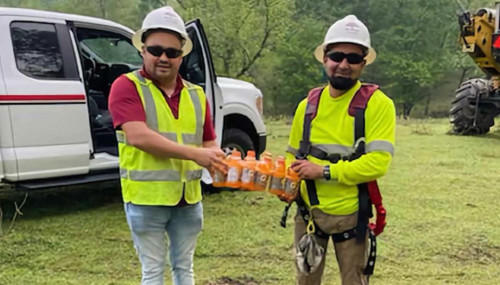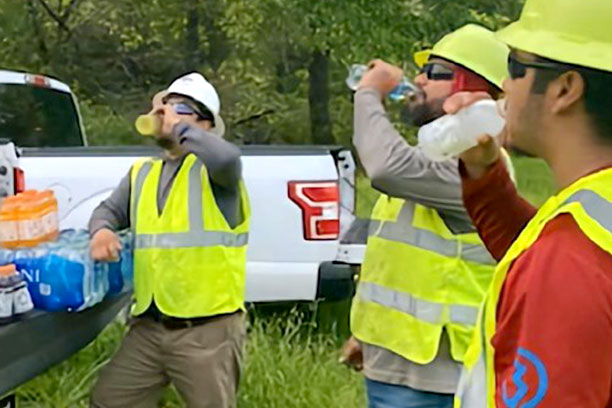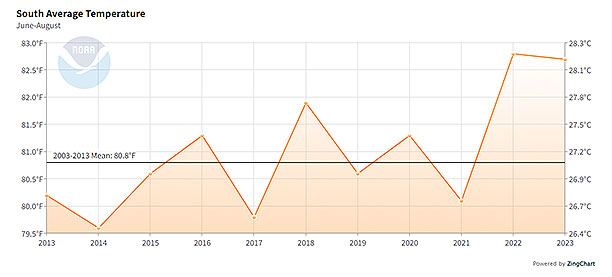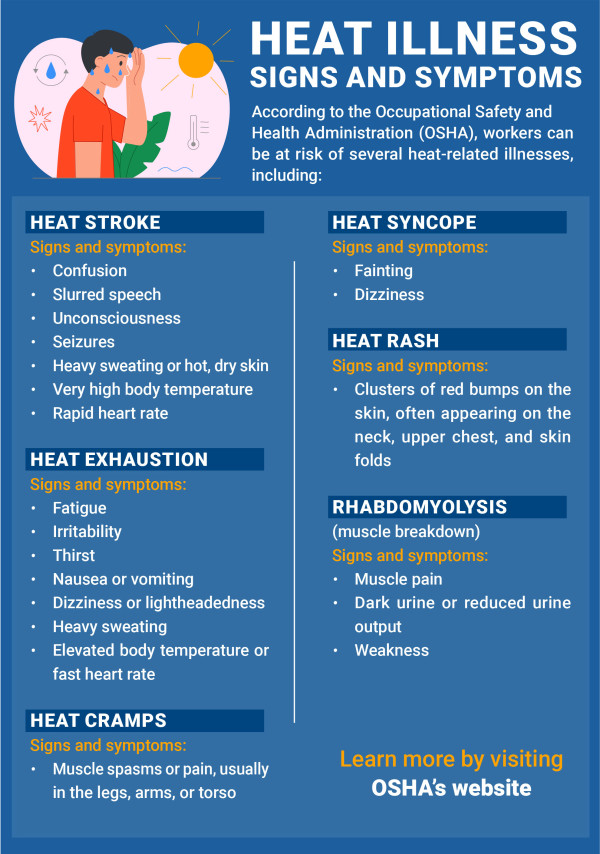Diego Canto Dereza, a Divisional Supervisor at Lewis Services, knows heat. He works in a division of Lewis that covers northeast Texas near the border of Arkansas and Louisiana, so he’s used to the sweltering summers that are common in those areas. But last year, as soaring temperatures broke records all across the Southeast, he received word of an incident that stopped him, the utility he was contracted with, and most likely many others in the utility vegetation management industry who heard about the event, in their tracks.
Rising Temperatures, Rising Risks: The Fight Against Heat in Utility Vegetation Management and Beyond
 Lewis teams use a variety of tools to beat the heat
Lewis teams use a variety of tools to beat the heat

In the last 30 years, heat has killed more people than any other weather-related event.

We all remember the headlines from last summer. “Severe heat wave in southern U.S. remains entrenched as records mount,” read The Washington Post. “Summer 2023 was hottest on record, scientists say,” declared Reuters. That summer, Canto Dereza, his General Forepersons (GFs), and their crews were working on a job in Shreveport, LA. “Around 9, 10 o’clock in the morning, it was already 100-101 degrees,” he recalls.
After 4 consecutive days of record-breaking temperatures, Canto Dereza received concerning news from the utility. An employee under a different company who was also contracted with the utility had almost passed out from the heat. He had stopped sweating all together, felt fatigued, had dry skin, and experienced a loss of awareness. The employee had come down from the Northeast to help with the work and was not used to operating in such heat. Once his team noticed his symptoms, they immediately took him into a cooler environment for him to recover. This event caused everyone to realize that waiting for something to happen was the wrong approach to dealing with sky-high temperatures.
As summers get hotter and hotter, the call for increased protections against heat-related health concerns becomes more and more urgent. It’s what makes heat planning within the utility vegetation management industry and in local governments so important. While governments and businesses everywhere talk and debate methods to abate rising temperatures, organizations with workers exposed to extreme heat are taking steps to adapt to this new reality.

Heat Action Plans

Lewis employees take a break to hydrate
According to the Adrienne Arsht-Rockefeller Foundation Resilience Center, a heat action plan is a roadmap that outlines how a community will respond to and reduce the impacts of extremely hot weather, which can include health issues (like heat stress and heat stroke), agricultural loss, labor productivity losses, and increased energy demand.
Dr. Ashley Ward, Director of the Heat Policy Innovation Hub at Duke University’s Nicholas Institute for Energy, Environment & Sustainability, is just one of the many professionals around the world working with communities to develop heat action plans. Her work focuses on the impacts of climate extremes on health and community resilience, according to her biography on the Institute’s website.
The incident Canto Dereza remembers from last summer probably wouldn’t be too surprising to Dr. Ward.
“In the last 30 years, heat has killed more people than any other weather-related event,” she says.
According to the Centers for Disease Control, an average of 658 people die from extreme heat annually, making heat-related deaths “one of the deadliest weather-related outcomes in the United States.” In fact, in 2022, the number of heat-related fatalities totaled more than fatalities due to floods, tornados, and hurricanes combined, according to the National Weather Service. Dr. Ward says many fail to recognize heat for the dangerous event it can be partly because of a lack of communication, but also because of general misperceptions.

One thing I’ve grown to love so much about Lewis is that we say we’re a family. The crews would do anything for each other, and I think that their personal wellness is a high priority for them when they’re out in the field.

Currently, extreme weather-related heat events are not defined as disasters in the Stafford Act, a disaster declaration framework that dictates how the federal government responds to disasters. One of the ways this framework classifies disasters is based on the amount of property loss associated with the event, which makes it difficult to incorporate heat-related weather events into the current framework. Additionally, the general public doesn’t seem to perceive itself to be at risk when it comes to extreme heat. “After a hurricane, there’s no doubt in anyone’s mind what just happened. That’s something that captivates the imagination. It’s scary to see all the trees down and the power out,” Dr. Ward explains. “So, people tend to view that as a riskier situation when, in fact, far more people die from just everyday exposure.”
Dr. Ward says a significant reason why so many deaths are prevented during emergencies like hurricanes is because there are plans in place at every level of government to both prepare for those events and react to the resulting damage. The same cannot be said for heat-related weather events, at least not yet. Dr. Ward and others across the nation and world are making strides to change that.
In North Carolina, Dr. Ward’s organization joined forces with the North Carolina Office of Recovery Resiliency, the North Carolina Department of Public Health, and the North Carolina State Climate Office, along with counties across the state, to develop a Heat Action Plan Toolkit, which was released in April of this year with the goal of reducing heat-related health impacts to workers and residents in North Carolina.
“I’m very excited that North Carolina has been such a leader on this,” Dr. Ward says.
In other places around the USA, communities are recognizing the need to formally address this issue similar to the way North Carolina has. In 2021, the City of Miami, Florida, named Jane Gilbert as the world’s first Chief Heat Officer. In this role, Gilbert works with various organizations, including Miami-Dade County, the National Weather Service, and health departments, to “identify ways [to] mitigate the heat through urban development patterns and reduce actual local temperatures and ‘feels like’ temperatures,” according to a profile on Barnard College’s website. And the City of Phoenix, which released an updated heat response plan in 2023, created the world’s first publicly funded municipal office focused on managing extreme heat in 2021.

Beating the heat in utility vegetation management

Climate at a Glance: Regional Time Series, www.ncei.noaa.gov
Heat action plans and general heat policies are just as important in the workplace as they are at the government level, especially for outdoor workers. Alaina Zieglar, Director of Safety and Human Performance at Lewis, says heat illness prevention is key to keeping Lewis’ outdoor workforce safe.
Lewis has a heat stress policy in place and provides training and refreshers to its distributed workforce throughout the summer season. Fortunately, Zieglar says she’s found that Lewis employees take heat very seriously. Part of the reason for that awareness is that utility vegetation management contracts can take crews to remote job sites where emergency services aren’t around the corner, so they need to be prepared to deal with challenges like this in advance.
“One thing I’ve grown to love so much about Lewis is that we say we’re a family. The crews would do anything for each other, and I think that their personal wellness is a high priority for them when they’re out in the field,” she says.
In Canto Dereza’s division during the summer of 2023, the heat-related incident experienced by the other contractor led to even more communication and reminders to his team. Lewis teams use a variety of tools to beat the heat, including regular drink breaks, cooling towels, sunscreen, protective clothing, and hydration tracking sheets. Canto Dereza also reminds his GFs that a simple visual inspection of their employees goes a long way.
“We encourage GFs to visually inspect everyone and talk to them to make sure everybody is focused in the morning and throughout the day,” he says.

The future of heat planning
Dr. Ward says the future of heat planning will depend on the region and area. What works in urban areas may be different from approaches taken in rural areas. There are also socioeconomic factors to consider when developing solutions. Telling people to get into air conditioning isn’t effective when cost and accessibility are prohibitive. But Dr. Ward is hopeful that more education and outreach will be done to protect workers and the general public from heat-related health risks.
“The solutions aren’t going to come from looking at just one aspect of the problem. It’s going to have to be a real coordinated and integrated effort,” she says.

Heat illness signs and symptoms
According to the Occupational Safety and Health Administration (OSHA), workers can be at risk of several heat-related illnesses.
Learn more by visiting OSHA’s website

The solutions aren’t going to come from looking at just one aspect of the problem. It’s going to have to be a real coordinated and integrated effort.




